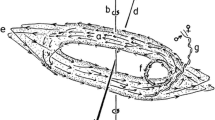Summary
Hollow swarmers are budded off at the dorsal surface ofTrichoplax and are covered by dorsal epithelium. Their inner cavity is lined with the flagellated cells of the ventral epithelium. There is no indication that the fiber cells included between the epithelia take any part either in morphologenesis or the separation of the bud from the mother animal. The early primordium forms in the interspace. A single layer of cells derived from both epithelia surrounds a cavity filled with granular matter that stains like proteins. The latter is used up during the floating phase of the swarmers that may last for a week. After settling at the bottom, the hollow sphere opens at one point. The concave ventral epithelium gradually flattens as more cells become incorporated in it. The latter form new flagella and flagellar pits. More frequently found than swarmers are small spherical forms that are unable to float and possess a distinct polarity. Their upper half is covered by dorsal epithelium and their lower half by ventral epithelium. Large fiber cells are in the center. Their site and mode of formation is unknown. Rarely observed are dorsal stolons whose bulbous end flattens upon touching the substrate. Since they are totally covered by the flat cells of the dorsal epithelium, they may have to undergo a transformation, like the hollow swarmers, to bring the ventral epithelium into contact with the substrate.
Similar content being viewed by others
References
Allen RE (1980) Staining protein in isoelectric focusing gels with fast green. Anal Biochem 104:494
Behrendt G, Ruthmann A (1986) The cytoskeleton of the fiber cells ofTrichoplax adhaerens (Placozoa). Zoomorphology 106:123–130
Birnstein VJ (1989) On the karyotype ofTrichoplax sp. (Placozoa). Biol Zentralbl 108:63–67
Grell KG (1974) Vom Einzeller zum Vielzeller. Hundert Jahre Gastraea-Theorie. Biologie in unserer Zeit 4:65–71
Grell KG, Benwitz G (1971) Die Ultrastruktur vonTrichoplax adhaerens F.E. Schulze. Cytobiologie 4:216–240
Grell KG, Benwitz G (1981) Ergänzende Untersuchungen zur Ultrastruktur vonTrichoplax adhaerens F.E. Schulze (Placozoa). Zoomorphology 98:47–67
Ivanov DL, Malakhov VV, Tzetlin AB (1980) Fine morphology and ultrastructure of a primitive multicellular organism (Trichoplax sp. I. Morphology of adult and vagrants by the data of scanning electron microscopy (in Russian). Zool J 59:1765–1769
Ruthmann A (1977) Cell differentiation, DNA content and chromosomes ofTrichoplax adhaerens F.E. Schulze. Cytobiologie 15:58–64
Ruthmann A, Terwelp U (1979) Disaggregation and reaggregation of cells of the primitive metazoonTrichoplax adhaerens. Differentiation 13:185–198
Ruthmann A, Behrendt G, Wahl R (1986) The ventral epithelium ofTrichoplax adhaerens (Placozoa): Cytoskeletal structures, cell contacts and endocytosis. Zoomorphology 106:115–122
Schulze FE (1891) ÜberTrichoplax adhaerens. Physikal Abh Kgl Akad Wiss Berlin 1–23
Schwartz V (1984) Das radiopolare Differenzierungsmuster beiTrichoplax adhaerens F.E. Schulze (Placozoa). Z Naturforsch 39c:818–832
Thiemann M, Ruthmann A (1988)Trichoplax adhaerens F.E. Schulze (Placozoa): The formation of swarmers. Z Naturforsch 43c:955–957
Thiemann M, Ruthmann A (1989) Microfilaments and microtubules in isolated fiber cells ofTrichoplax adhaerens (Placozoa). Zoomorphology 109:89–96
Author information
Authors and Affiliations
Rights and permissions
About this article
Cite this article
Thiemann, M., Ruthmann, A. Alternative modes of asexual reproduction inTrichoplax adhaerens (Placozoa). Zoomorphology 110, 165–174 (1991). https://doi.org/10.1007/BF01632872
Received:
Issue Date:
DOI: https://doi.org/10.1007/BF01632872




